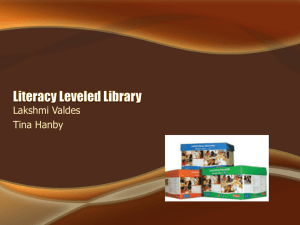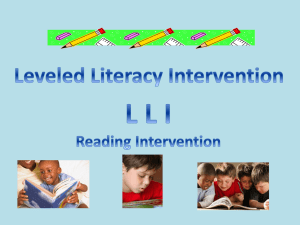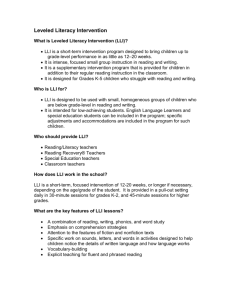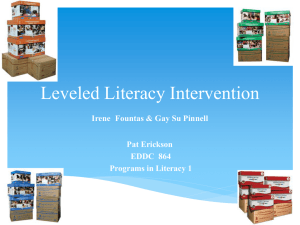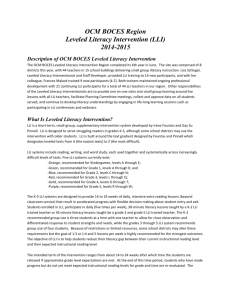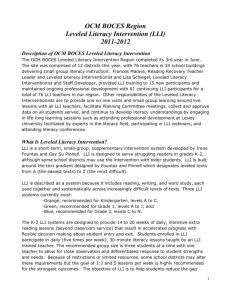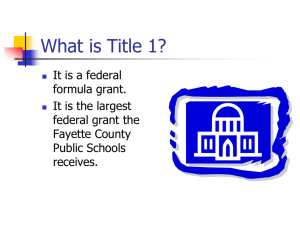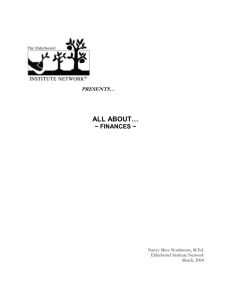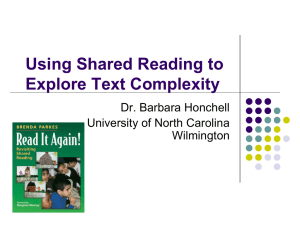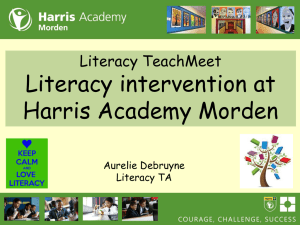LLI Classroom Connections - GSSD Blogs
advertisement
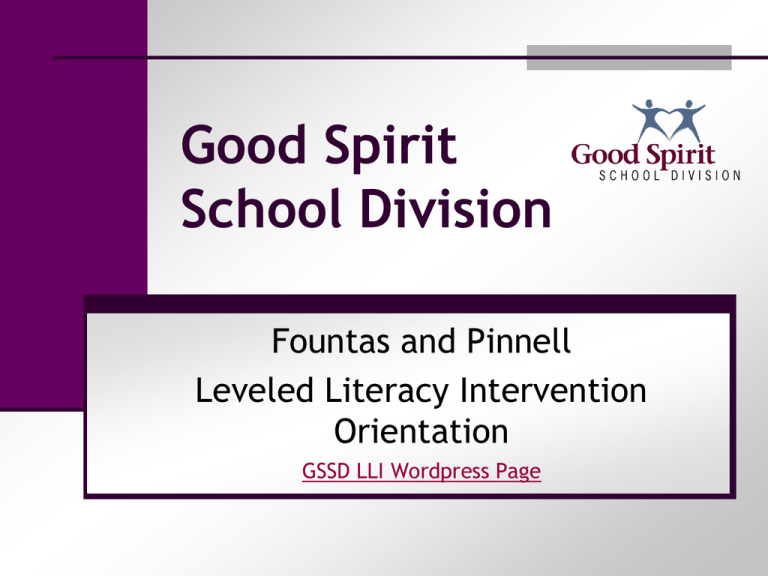
Good Spirit School Division Fountas and Pinnell Leveled Literacy Intervention Orientation GSSD LLI Wordpress Page GSSD LLI Site 2 What is LLI? LLI is a small-group (no larger than 3 students), supplementary intervention program designed for young children who struggle with reading and writing. LLI is a powerful, research-based early intervention program that can prevent literacy difficulties before they turn into long-term challenges. 4 1. Supplemental To the daily literacy block occurring within the classroom which should consist of all the balanced literacy components including guided reading. 2. Daily 30 minute sessions Reinforce new learning and support accelerated program Students engage in reading, writing, word study 10 minutes assigned beyond the 30 minute session dedicated for student transition 3. Small Groups Three students maximum Close observation by the LLI teacher facilitates teaching Individual learning leads to faster progress 4. Short Term System designed to bring students up to grade level in 18-24 weeks 5. Structured Lessons Very structured framework (children learn the routines) LLI teacher makes decisions specific to observations 6. Fast Paced Intensive and rigorous Pace keeps students engaged in successful experiences Use of a timer Preserve the 30 minutes 7. Deep Comprehension Throughout the reading process – before, during, after reading Beyond literal interpretation Within text About text Beyond text 8. Writing Writing is integral for success. Strong reading and writing connection. Students compose, construct, and develop essential strategies for in the classroom. 9. Fluency Fluency is critical Each lesson includes attention to fluent, phrased reading as well as fluent writing If a student is not fluent, progress is hampered 10. High-Quality Text Multiple copies of levelled texts Designed to engage young readers with high quality fiction and nonfiction selections Texts have been systematically crafted to build phonics and word analysis skills and arranged along a careful gradient of text characteristics 11. Word Work Focus on phonological awareness, phonemic awareness, letter-sound patterns (phonics), word structure, spelling patterns, high frequency words Word work is critical but not to the exclusion of comprehension (balanced literacy) 12. On-Going Assessment More than pre-test, post-test Ongoing Running records (at least weekly) Comprehension-checks Word recognition 13. Professional Learning The LLI school team must engage in professional learning Understanding of the reading process is an important determinant of student success LLI team can refer to the Program Guide, Professional DVD, When Readers Struggle, LLI website to support their collaborative learning 14. Classroom Connections Critical to student success Record-keeping documents should be shared and reviewed Successful strategies in intervention/classroom are shared for consistency 15. Home Connection Materials reflecting student interest, culture Share success with students, families Shared expectations Who is LLI for? LLI is designed to be used with small groups (3) of children who need intensive supports to achieve grade level competencies. For example: the lowest achieving children in the classroom who are not receiving other supplementary interventions; children who have English as an additional language; children that have been identified as children with intensive needs. Other Considerations For Selecting Students for Intervention Use Benchmark Assessment System (F&P) results to select and group children Begin with students who need the most help The levels should be the same within the group Students should be re-grouped where necessary Most children can be brought to grade level in 18-24 weeks LLI Systems There are three LLI systems available coded by color: The Orange system (Levels A through C) The Green system (Levels A through J) The Blue system (Levels C through N) 24 25 Getting Organized Find a space where the children are able to face the LLI teacher and see the materials. In advance, print out materials from the Lesson Resource CD. Initially using the system will require the LLI teacher to plan ahead of time so the materials are ready. Review the week’s lessons. Lessons are designed for minimal planning once you get used to the structure. Essential Elements of Lessons There are three kinds of lessons: Getting Started Lessons (Orange and Green Kit) Odd Numbered Lessons (Orange, Green, and Blue Kits) Even Numbered Lessons (Orange, Green, and Blue Kits) Getting Started Lessons Include: Rereading – 5 minutes Phonics – 5 minutes Rereading a new book with several levels of support – 8 minutes Writing about reading – 7 minutes Letter word work – 5 minutes Note: The last Getting Started lap book is level D in the Green System. There are lap books throughout the orange kit. Odd Numbered Lessons Include: Rereading Books – 5 minutes Phonics/Word Work – 5 minutes New Book – 15 minutes Letter/Word Work – 5 minutes Even Numbered Lessons Rereading Books and Assessment – 5 minutes Phonics/Word Work - 5 minutes Writing about Reading – 15 minutes New Book – 5 minutes Optional Letter Word Work – no time specified Professional Development DVD Teaching Selection of students Getting Organized Getting Started Lessons LLI Framework Instructional Routines (Sampling of Routines) Record Keeping All Lessons Include the following Materials 1. Classroom Connections 2. Home/School Connections 3. Assessing Reading/Writing Behaviors 4. Supporting English Language Behaviors 5. Professional Development Units 1. Classroom Connections Critical - Collaboration and communication between the classroom teacher and LLI teacher. Includes specific suggestions for children to practice and extend their learning in the classroom. This includes rereading the take-home book. Link to LLI Classroom Connections located in LLI Training and Information Content and progress need to be communicated (GSSD LLI Guidelines) Build Classroom Connections by Coordinating with the Classroom Teacher Invite the classroom teacher to observe an LLI lesson(s). Share records on an on-going basis. Ask for their input and for what they are seeing in the classroom. The classroom teacher is using guided reading daily, especially for LLI students. Use the Classroom Connections. 2. Home/School Connection Includes specific suggestions for children to practice and extend their learning at home. All take home resources are on the Lesson Resources CD-ROM. 3. Assessment and Record Keeping Ongoing assessment is built into the system : Assess one student every second day Which means every child will get assessed once a week (approximately) Record Keeping: Keep record keeping simple, efficient and informative After each lesson (or at least daily), time is necessary to complete the records. Record keeping forms are found on the Lesson Resources CD Additional assessment records are located on LLI Training and Information Wordpress site. Reading Records Reading records monitor progress and teaching. They are the same as BAS reading records. Professional Development and Tutorials are available for review and additional practice of how to keep reading records. Coding and Scoring Errors at a Glance are used for reading records (Chart to help you) Intervention Record Student files include your: anecdotal notes running records work samples LLI reading graph attendance record Professional Development and Tutorial DVD’s While you are assessing one of your students during an EVEN lesson, the other students are whisper reading previous books from the last lesson and other lessons. Refer to Practice Tutorials on the DVD’s to become comfortable with this process. Coding Oral Reading Running Records Specifics: Analyzing Errors and Self Corrections Meaning-Structure-Visual Information Meaning • Did the meaning of the text influence the error? • Did it MAKE SENSE? Structure • Does the error fit an acceptable English language structure • Did it SOUND right? Visual Information • Did the visual information from the print influence any part of the error? • Did it LOOK right? Scoring and Analyzing Oral Reading Behaviours Analyzing Strategic Actions Think of readers as problem solvers: What strategies are they using to figure out words and meaning? The Guide for Observing and Noting Reading Behaviours (located on the Lessons Resources CD) suggests that the student might be using some or all of the following strategies: • Early Reading Behaviour • Searching For and Using Information • Solving Words • Self-Monitoring • Self-Correcting • Maintaining Fluency Prompting Guide: A tool to support the students as they read or write Gives specific language to teach for strategies in reading and writing Section 1 and 2: Teaching for Strategic Action in Reading and Writing 44 Joey Case Study 45 4. Professional Development Each kit includes PD and Tutorial DVDs and the book When Readers Struggle A bibliography is found at the end of the Program Guide for additional resources. Questions? 47 Final Thoughts Follow the fidelity of the program, communicate and collaborate as a LLI Team The more you do it right as it is laid out and intended, the more growth you will see. 48
